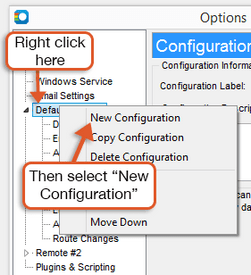Version 5 Manual
Named Configurations
Important
PingPlotter Professional's features have been modified in its latest version. Learn more.
So, we know that PingPlotter Pro allows us to trace to multiple targets in the same instance. What if, however, we want to use different settings on different targets? For instance - for one target we want to use TCP packets, but want to use ICMP packets on another. Or maybe you want to trace a few of your targets from a remote agent location. PingPlotter Pro can do this through the use of named configurations.
We can access (as well as create and manipulate) our named configurations in PingPlotter by going to the “Options” menu (“Edit” -> “Options” on Windows - "PingPlotter" -> "Preferences" on Mac). When you first install PingPlotter you’ll have one named configuration (appropriately named “Default Settings”). Under the configuration name we see a number of other “configuration specific” areas (such as “Display” and “Engine,”). The values that we configure in these areas are all a part of this specific named configuration. At any time, we can edit the name, or make chances to any of the values.
 To create a new named configuration, all we need to do is right-click on any existing configuration, and then select “New Configuration.” If you’ve got a configuration already set up, and need to set up another that’s similar (with minor tweaks), you can right click on that configuration and select the “Copy Configuration” option. Any changes that you make to a specific configuration are *not* carried over to any other named configurations.
To create a new named configuration, all we need to do is right-click on any existing configuration, and then select “New Configuration.” If you’ve got a configuration already set up, and need to set up another that’s similar (with minor tweaks), you can right click on that configuration and select the “Copy Configuration” option. Any changes that you make to a specific configuration are *not* carried over to any other named configurations.
Once we’ve created a new configuration, it’s always a good practice to rename it (and give it a good, meaningful name). Some example configuration names could be:
- TCP Port 80
- Auto-Save every 30 minutes
- VoIP
- Remote via our website
There’s also an option to enter a description - which can prove helpful (in case you come back to a configuration and wonder why it was made, and what it was for).
Once you’ve got everything set up to your liking, and close down the “Options” menu, you’ll notice a drop-down box in the target bar labeled “Settings.” This field lists all of the named configurations we have set up.

Changing this drop-down will change the currently running target to use that named configuration. You can change multiple targets to use a specific configuration by selecting them on the summary screen and changing the settings field (the changes will take effect immediately once selected).
To use TCP packets you'll need to use a packet generator as most operating systems today block the ability to create TCP packets with the options needed for traceroute. PingPlotter supports the use of Nmap's Npcap packet capture library for Windows.
A note about Npcap
While PingPloter can use Npcap to generate TCP packets, it is a third-party framework and may be made incompatible through future updates. If you encounter compatibility issues with Npcap, please reach out to our Service Team.
**The feature in this topic is exclusive to PingPlotter Pro. See our product comparison page for more details**